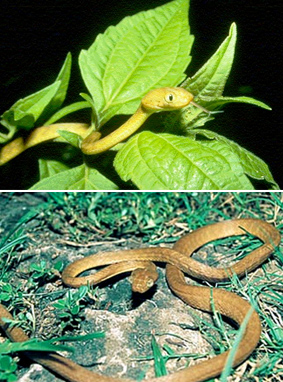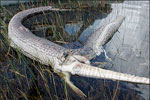In a spectacularly creative effort to rid Guam of an invasive species, the US Department of Agriculture is planning to ‘bomb’ the island’s rainforests with dead frozen mice laced with acetaminophen. The mice-bombs are meant to target the brown tree snake, an invasive species which has ravaged local wildlife, and angered local residents, since arriving in the 1940s.
The idea is to poison snakes by getting them to ingest the acetaminophen-containing rats. In sufficient dosages, Acetaminophen, the primary ingredient in Tylenol, can cause liver failure in snakes (and humans, for that matter).
While it might not seem difficult to purge an island of snakes, the snake’s habit of dwelling high in the rainforest canopy has so far thwarted efforts to rid the island of the pest. The difficulty of reaching the snakes’ habitat has led to the idea of mice-bombs as a possible solution.
 Conservationists have come up with a novel method to rid Guam of the invasive brown tree snake. In sufficient dosages, acetaminophen, the dominant ingredient in Tylenol, causes irreparable damage to the snake’s liver, killing the snake. Photos by USGS. |
Initially mice were tested with a variety of ‘delivery systems’ until researchers with the National Wildlife Researcher Center in Fort Collins, Colorado settled on a streamer attached to cardboard on which the mouse is affixed via glue. This contraption is meant to catch in the tree tops: perfectly positioning itself for hungry brown tree snakes. Researchers want to make certain the mice don’t make it all the way to the ground where they could threaten local wildlife such as crabs and lizards [PDF].
The mice-bomb program is currently underway with Dan Vice, assistant state director of the US Department of Agriculture’s Wildlife Services in the Pacific, telling Radio Australia that 250 poisoned mice have so far been dropped in a trial run. Researchers are now working to see if the preliminary mice-bombs worked.
An effective snake eradication result would deliver relief for the island’s beleaguered native bird species—six of which have gone extinct since the brown tree snakes appeared. It might also cut bills for taxpayers: the brown tree snake costs $1-4 million dollars in direct damages and lost productivity per yer due mostly to snaked-caused power outages, which occur at a rate of roughly one every three days.
Related articles
Photos: rats drive island lizard to extinction
(06/29/2010) The Selmunett lizard (Podarcis filfolensis ssp. Kieselbachi) is very likely extinct, according to Maltese naturalist Arnold Sciberras. One of four subspecies of the Maltese wall lizard, the Selmunett lizard was last seen in 2005. Although the lizard’s home—Selmunett Island—has long been uninhabited by people, that fact did not help save the lizard. Over-predation by introduced rats is thought to be the primary cause of lizard’s extinction.
Florida announces python hunt following snake invasion
(07/16/2009) Florida has authorized a cull of Burmese pythons that have invaded the Everglades and other wetland areas, reports the Associated Press.
World’s only blue lizard heads toward extinction

(03/07/2007) High above the forest floor on the remote Colombian island of Gorgona lives a lizard with brilliant blue skin, rivaling the color of the sky. Anolis gorgonae, or the blue anole, is a species so elusive and rare, that scientists have been unable to give even an estimate of its population. Due to the lizard&spod;s isolated habitat and reclusive habits, researchers know little about the blue anole, but are captivated by its stunning coloration.
Python explodes after swallowing 6-foot alligator in Florida Everglades

(10/05/2005) The National Park Service released photos that show the carcass of an American alligator that was almost swallowed by a Burmese python. Park officials discovered the animal carcasses in a remote part of Everglades National Park, in south Miami-Dade, Florida, on Monday, Sept. 26, 2005. It appears that the 13-foot long Burmese python attempted to swallow the six-foot alligator before its stomach ruptured, resulting in the deaths of both animals.
